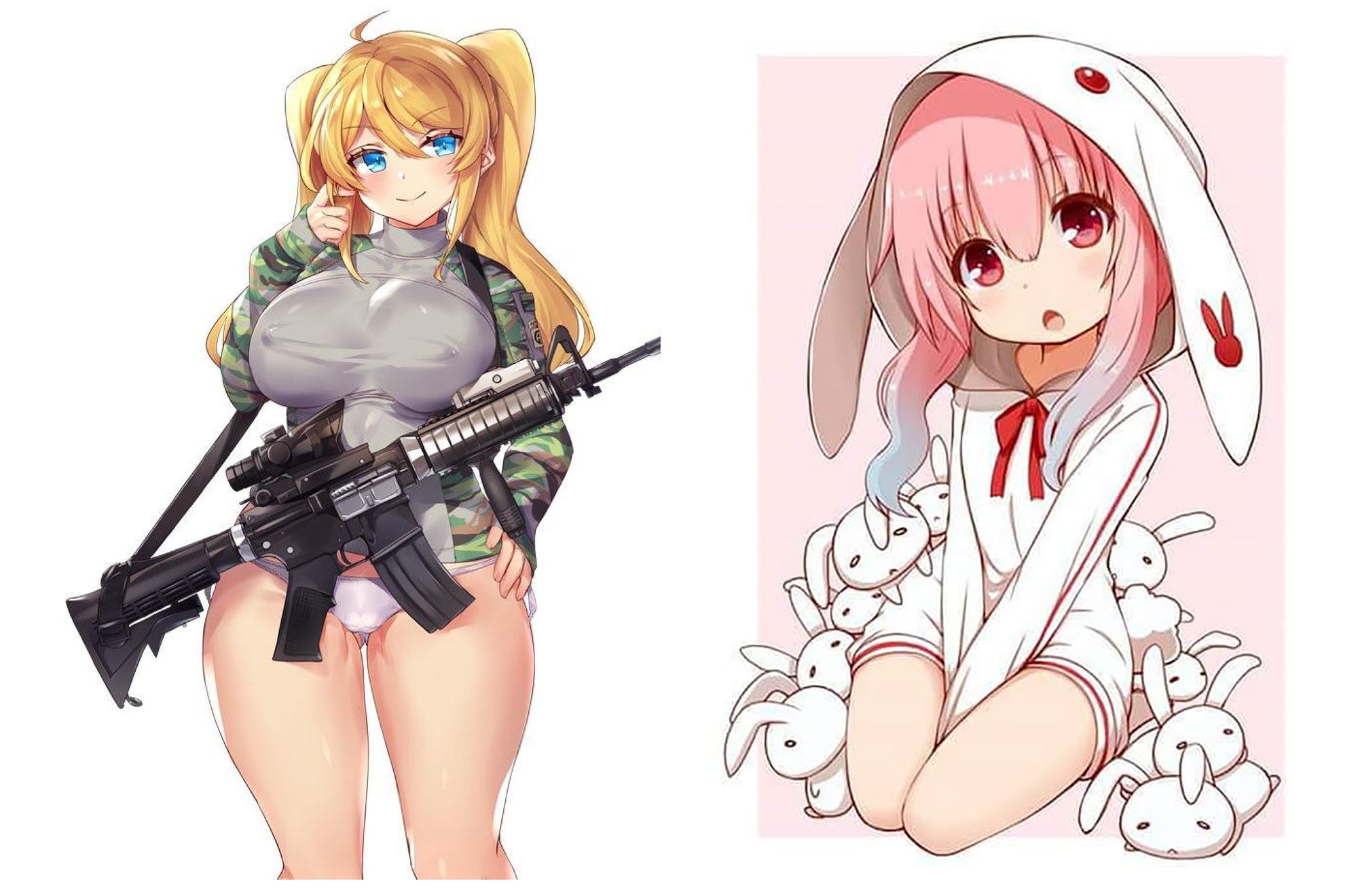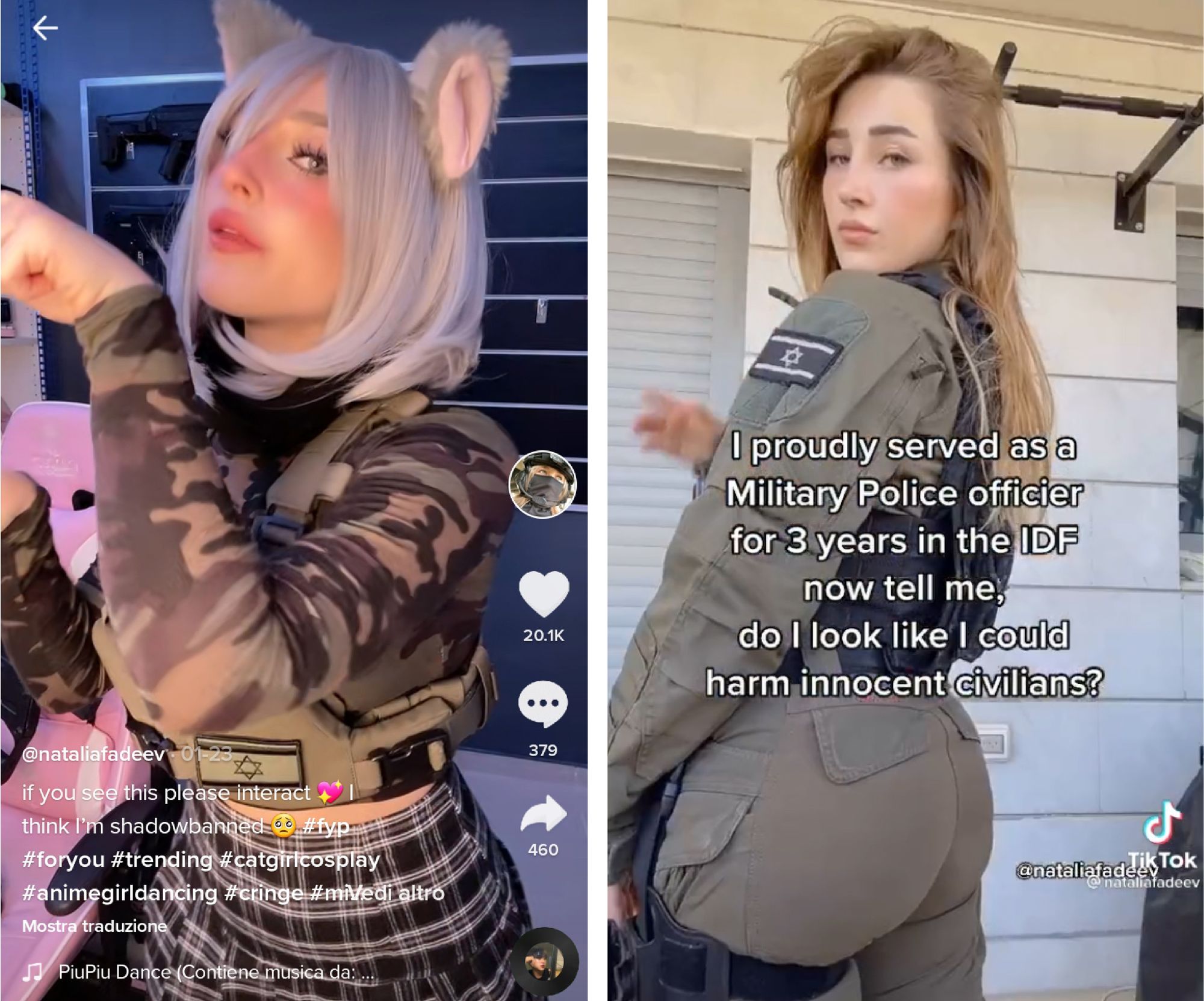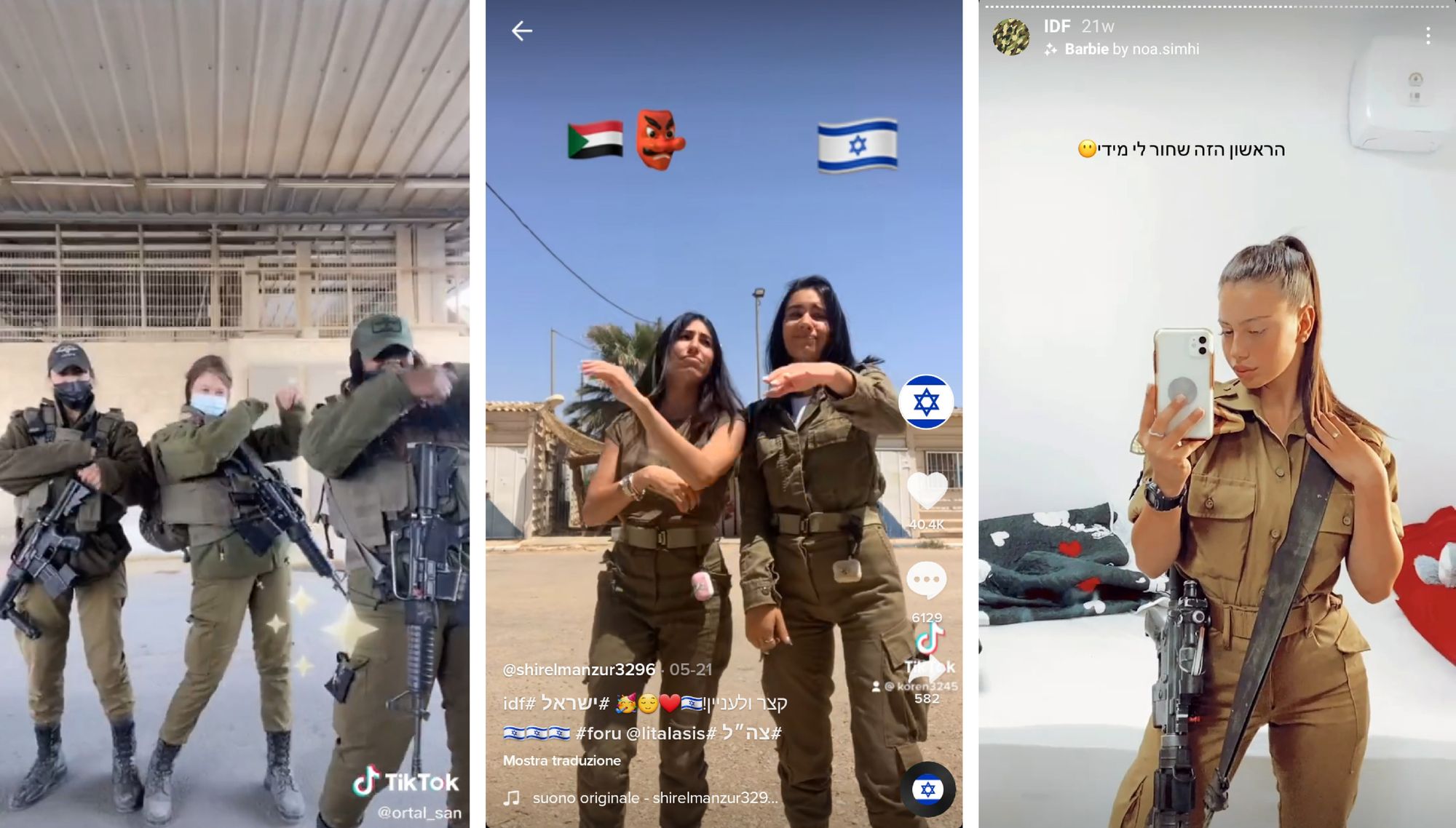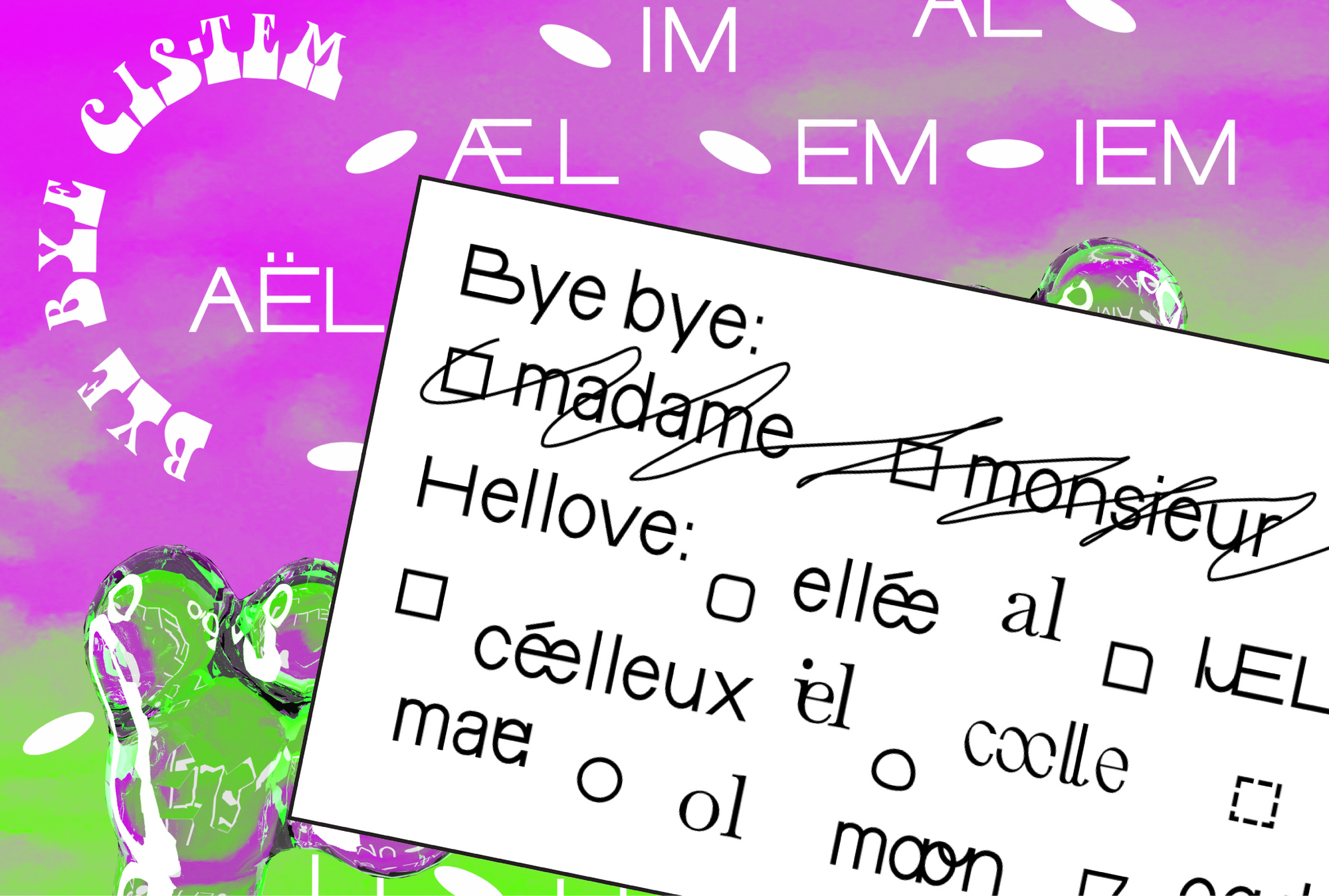
What could the pastel-coated aestheticization of violence on social media, the Israeli army, and anime fandoms possibly have in common? For centuries, Western art and media have used aesthetic devices to present horrific realities through a beautifying glass. With the widespread use of digital media, this practice has entered the virtual sphere, where memes—often verbally aggressive or cynical—are translated into tender and cute aesthetics, pastel colors, and lovely characters like Mimmy or Charmmy Kitty, adorned with hearts and ribbons and marked by pretty fonts. Some gifs or graphics are turned into purchasable pins and socks displaying messages such as “Please Die” framed in a pink heart or the meme “We are going to beat you to death” surrounded by plushies. Suddenly, what first appeared to be rude and corrosive now seems incredibly sweet and mild.
At first glance, I dismissed the memes as insignificant and harmless, but as I delved deeper, I discovered a whole ecosystem of microcultures and living digital fauna. Exploring this pink world, “cuteness” became my guiding light, leading me to discover hidden secrets—the dark underbelly of the “happycore aesthetic” that is far from its positive image of a wholesome, safe space: the unsettling, triggering “traumacore.”

Kawaii
The Japanese Kawaii culture—based on the term “Kawaii” which means “cute” or “adorable”—originated in Japan during the 1970s primarily through the use of low-cost stationery goods and childlike handwriting, and it quickly became popular among students as a means of self-expression. Author Kumiko Sato in her book “From Hello Kitty to Cod Roe Kewpie: A Postwar Cultural History of Cuteness in Japan” argues that cuteness emerged as a response to the rigid and hierarchical society of post-World War II Japan. As political and social awareness began to shift in the 1960s and 1970s, mass media and the commodification of goods began to dominate and shape lifestyles, leading to an irreversible phenomenon of consumerism that impacted people’s mindsets, habits, and lifestyles.
In 1974, Sanrio, a company specializing in character creation and marketing, was founded in Japan, and its most recognizable character Hello Kitty made her debut on a vinyl coin purse. The company’s founder, Shintaro Tsuji, believed their characters had an inherent relational value justifying their mass production: “They delight, they express people’s sentiments, they foster friendships, they put smiles on faces.” Since then, the “cute” craze has captured the hearts of millions worldwide.
Kawaii culture began to gain popularity in the West during the 1990s, when the rise of globalization and the spread of capitalism helped to make Japanese pop culture more accessible to Western audiences. With its emphasis on cuteness, innocence, and childlike behavior, this surge can be seen as a reaction to the cultural shift, offering an alternative to the more aggressive and masculine cultural norms of the time. In the West, young people in particular, used the Kawaii aesthetic as a way to express themselves and their individuality, rejecting mainstream cultural norms and embracing a more playful and lighthearted approach to life.
“The 1990s saw the emergence of the girl power movement [...] which challenged the dominant cultural narrative that women should be submissive and subordinate to men.”
At the same time, the 1990s saw the emergence of the girl power movement—emphasizing female empowerment, independence, and representation—which challenged the dominant cultural narrative that women should be submissive and subordinate to men. The rise of consumer culture in the 1990s enabled the marketing and selling of girl-power-themed products, which was closely linked to the rise of neoliberal capitalism. While this commercialization made girl power a profitable industry for corporations and media companies, it also depoliticized the movement, shifting the focus away from a collective social change towards individual empowerment and market-driven values, often targeting young girls to express their individuality through consumption rather than collective action or political engagement.
Indeed, my whole childhood in Milan, Italy, during the 1990s was heavily influenced by the Western hyperconsumerism of the time and led by “Pink totalitarianism.” As an only child, I found comfort in my collection of gel pens, pastel ribbons, and hair pins in matching cotton candy shades of pink—a color that has always attracted my attention with its cute and charming qualities. Objects that embody cuteness and vulnerability evoke a deep emotional attachment within me, inspiring an instinct to cherish and protect them. To me, Kawaii serves as a poignant metaphor for the universal human experience of vulnerability, expressed through the act of seeking comfort in objects that affirm our needs. As I accumulated mass-produced mechanical pencils and fancy decorative stickers, I realized that what I sought to comfort and adorn was my own vulnerability.

Returning to the digital realm, the Kawaii culture continues to spawn a plethora of fandoms, private collections, and routines that fosters a sense of belonging and self-representation within specific online communities that identify themselves under its principles and aesthetics.
Imaginary of the female body
The Japanese comics and anime industry is closely intertwined with Kawaii culture, influencing gaming culture and the emergence of subcultures such as the e-girls, notably popularized by TikTok, which emerged in the late 2010s as a mixture of Japanese Lolita and thrift fashion, existing mostly in a digital-only world through the privacy of a bedroom with a fully-equipped customized pink gaming set-up.
In its earliest definition from 2009, the term “e-girl” was used as a slur on gaming sites, where a woman gamer could be objectified and become a target for derision, threats, and doxxing for merely being part of the community or trying to build a career in a predominantly male gaming world. The term was then later reclaimed by Gen Z as an empowering status.
The vast gaming subculture has long been linked to the imaginary of anime, manga, and cosplaying, which are characterized by three different graphic categories: waifu, hentai, and lolicon, frequently used in video game fandoms to reflect a range of visual expressions that are deeply ingrained within these subcultures.

Anime stereotypes heavily emphasize the eroticization of women’s bodies, ranging from explicit sexuality to more subtle forms of objectification. Unfortunately, these depictions have become prevalent among alt-right communities, and incels run Telegram channels, Discord servers, and threads on 4chan/pol.
One of the most common anime archetypes associated with this trend is the “waifu,” which refers to a fictional girl or woman, typically found in anime and manga, that inspires sexual attraction and obsession. The phenomenon of waifuism involves developing romantic feelings for a fictional character, sometimes even leading to the desire to marry the character—hence the term “waifu,” which stems from the Japanese pronunciation of the English word “wife.” Despite its innocent origins, waifuism has been co-opted by certain groups to perpetuate harmful dehumanization and unrealistic expectations of women.
The intersection of the Waifu culture and the U.S. 2nd amendment enthusiast movement over gun rights is becoming increasingly common, with weebs (Japanophiles) and pro-gun people alike using anime-inspired imagery and paraphernalia such as Dakimakura—body-sized pillows meant for hugging—to express their love for both. However, this fetishization of both guns and waifus has led to disturbing trends such as “unboxing the waifu” videos, which depict the idea of purchasing and unboxing a woman as if she were a commodity. Even more disturbing are low-quality photos shared on Reddit that depict firearms placed next to body pillows featuring female anime characters, implying an unsettling connection between violence and the sexualization of fictional characters. At its core, this combination of guns and waifus represents a dystopian para-reality in which the egomaniacal power of armed superiority is mixed with an unattainable perfection of a submissive, hypersexualized woman. Politically, this imagery symbolizes the triumph of radical conservatism, reinforcing a culture of “weaponized freedom” and promoting traditional gender roles of male domination and female submission.
The sexualized anime and gaming genres of hentai, waifu, and lolicon all rely on exaggerated and unrealistic portrayals of female and female-presenting bodies. Lolicon, in particular, features young or young-looking girl characters whose sexual desires are meant to be satisfied only in fiction. The kawaii culture’s influence goes beyond the gaming realm. A key figure in this trend of kawaii-fictionalization of life is Belle Delphine, a U.K.-based internet celebrity. Delphine is a popular e-girl-style cosplayer known for her hypersexualized persona that blends cute aesthetics with provocative content. Her signature style involves dressing up in a pink wig, displaying impish behavior, often portraying a cat-like persona, utilizing an infantile voice combined with suggestive winks, and ahegao, an exaggerated facial expression during intercourse commonly seen in anime and porn culture.

Belle Delphine’s brand shares features with kawaii culture, both being characterized by commodified fetishism. In January 2021, Delphine sparked debate with a Twitter post by suggesting ideas in the caption for a “perfect first date <3” while showing a picture of herself dressed in cute childish clothes, tied up with tape over her mouth, and being sexually assaulted by a man with his face covered. Outraged, disgusted, and shocked Twitter users were quick to backlash, particularly to her lack of a trigger warning for these crude images of violence promoting rape culture, but she refused to apologize. Another controversial issue was her music video Plushie Gun, which features her engaging in sexually suggestive behavior with guns. The video has since been repeatedly reported and canceled on YouTube.
The connection between weapons and kawaii culture is not uncommon, as seen in the use of anthropomorphic female characters on warships in video games, across the “Gunime” subreddit dedicated to a whole collection of the kawaii-fication of military tanks, or back in 2015 when Japan Self-Defense Forces (JSDF) decorated AH-1S Cobra attack helicopters with a moe, an adorable female anime character. In addition, booming tactical industries are keen to highlight the glamorization of weapons, emphasized by the strong anime influence in mass-produced lewd pin-ups and morale patches that evoke Japanese manga childhood nostalgia from the 1980s and 1990s to attract “military personnel, law enforcement officers, first responders, and responsibly armed civilians,” as online apparel store Weapons Grade Waifus states on its website.
Hello Kitty, one of the highest-grossing media franchises of all time, has also been seen in customized weapons—these are, of course, unauthorized by the producer. As my research intensified, I joined pro-gun online forums and communities to gather more information, and came across a bogus brand called Kalashnikitty that was popular for customizing apparel, with Hello Kitty holding an AK-47 rifle. It was disturbing to see pictures of young teens dressed in Kalashnikitty outfits holding rifles. Sebastian Masuda, a Japanese artist and expert in cute culture, once said, “Kawaii is unusual because it has this power to null[ify] negativity and evil,” but my research led me to observe a major oversight in how this can be used to deceive and disguise the perception of violence.
Digital militarism: how WW3 is getting to be super cute
What happens when cuteness meets ideological crisis and warlike propaganda? In May 2021, as the Israeli occupation forces brutally evicted Palestinian inhabitants from the East Jerusalem neighborhood of Sheikh Jarrah and bombed the Gaza Strip, social media became a powerful tool for amplifying the Palestinian struggle and organizing protests worldwide. However, as pro-Palestinian content was shadow-banned on Instagram, TikTok became a popular platform for sharing both pro-Palestine and pro-Zionist narratives, activism, and alliances. While the support for Palestine snowballed, millions of users were inundated with videos of young female soldiers from the Israeli Defense Force (IDF) appearing on TikTok’s main page or under the #foryou hashtag, one of the platform’s main trends.
Social media entertainment has become a powerful tool for governments and civilian users to promote their political agendas, particularly when it comes to defense, territorial integrity, and sovereignty. The Israeli Defense Force (IDF) has been using social media to coordinate its campaigns, especially during the 2008-2009 Gaza Strip incursion called “Operation Cast Lead.” Social media platforms have been used to affirm the “need” for the perpetual state of occupation in the Palestinian territories and to comfort moral concerns. The IDF’s TikTok account, launched in 2020, already has more than 148,000 followers. Israeli soldiers are often called “our children”' or “our boys,” when portrayed in movies or Instagram stories; their moral status is raised to relatable existential values similar to intrinsically vulnerable people despite the uniform, invoking a “friendly” and “harmless” nature regardless of the fact that they’re carrying guns.
“The use of ‘relatable’ tools [such as social media] to sugarcoat the brutal military occupation and ethnic cleansing is a strategy the Israeli military has employed for years to improve its image.”
In his book, An Army Like No Other, British filmmaker Haim Bresheeth-Žabner delves into the archetypal representation of IDF soldiers. He demonstrates how the contradiction between the “helpless” and the “weaponized” perfectly embodies “the right to self-defense” rhetoric, stating: “while Palestinian male children are described as young men when they die, Israeli soldiers remain boys when they kill.” This manipulation of facts contradicts documented rights violations, interfering with meaning. The more refined the propaganda tool becomes, the more it can stealthily normalize a perceptive process that would otherwise never be accepted or allowed. Bresheeth-Žabner highlights the need to infantilize language to dehumanize the victims, making it possible for thousands of soldiers to kill without guilt or remorse. Betraying reality through words requires a strengthening semiotic extension through image production.
In Digital Militarism: Israel’s Occupation in the Social Media Age, authors Adi Kunstman and Rebecca Stein note how contemporary violence in digital image production simultaneously heroizes and aestheticizes war while dissociating it from the resultant violence. The use of “relatable” tools to sugarcoat the brutal military occupation and ethnic cleansing is a strategy the Israeli military has employed for years to improve its image. Among other public relations stunts, the IDF painted a few F-16 jets pink to try to portray itself as a haven for women and queer people. The military has also encouraged female soldiers to use their social media accounts to spread the “truth” and improve the IDF’s reputation. Within this climate, two TikTokers gained major attention for portraying the Israeli military, albeit in different ways: Yael Deri, a former IDF Military Police Officer; and Natalia Fadeev, an IDF military police reservist.

Deri’s videos showcase her performing catchy dance moves while carrying an assault rifle during her daily routines as an IDF Military Police officer. In contrast, Fadeev’s content revolves around cosplay and waifus, heavily emphasizing hypersexualization and consumerism. Deri and Fadeev’s aesthetics significantly impact the visual processing and semantic reframing of violence and extremism. While Deri’s videos are similar to those of many other IDF female soldiers and are often collected in cringe fanbase accounts, Fadeev’s production is more heavily propagandistic; indeed, one of her online aliases is gunwaifu. Her staged pictures feature cleavage, the Israeli flag, infantile poses with helmet kitty ears, and an ahegao face, all of which serve to visually affirm an alleged “muscular” hypersexualized political superiority.
Beyond TikTok, Fadeev is also an airsoft (combat simulation) player, OnlyFans streamer, and part of Alpha Gun Angels, an Israeli weapons-modeling and social media marketing agency composed of IDF combat veterans turned into arsenal-accessorized influencers. Essentially, she is a real-life gun-equipped version of Belle Delphine. However, it is crucial to recognize the danger of sugarcoating the brutal reality of military occupation by using aesthetics to disguise the perception of violence. Despite the apparent entertainment value of their social media presence, both Yael Deri and Natalia Fadeev perpetuate harmful stereotypes and normalize brutal military occupation through their content. I call them self-generative propaganda machines: it’s the spontaneous urge to imitate and go viral that makes the process last and thrive.

Both of them frequently violated platform guidelines or faced user reports, leading to penalties such as Natalia’s account’s multiple shutdowns. However, Yael Deri is known for her composed attitude, which allows concealing violence in a less conspicuous manner. This is reflective of a fatal obsession with beautification and cuteness that is not only conceived as a performance of power, but also encouraged as a value to pursue. In fact, in November 2021, the Israeli Defence Forces bestowed a first-of-its-kind award to Deri for “the strengthening and improvement of the reputation of the Military Police Corps” on TikTok. This award reflects a troubling reality in which military operations are transformed into a prize-winning game through lip-syncing, while lewd pictures of soldiers present violence as a source of pleasure. It is a disturbing and extreme parody of life imitating itself.
As we consume each of these videos in our own private dimensions, we atomize ourselves surrounded by random, often uncategorized, and scattered memories of bits of violence that our perception can barely elaborate on since its original correspondence to our archetypical overview of violence has been adulterated. Our speed of consumption is proportional to the pace of our own visual metabolism, which is proportional to the speed of each 30-second TikTok video.
“It is evident that social media has become its own weapon of war in countries in conflict.”
In recent years, we can see surging popularity across social media for hashtags like #army and #miltok (a portmanteau of “military” and “TikTok”); however, more specific terms like #usarmy and #militaryrecruiter are notably far less popular. It is evident that social media has become its own weapon of war in countries in conflict; through shaping public perception, it becomes a stage to showcase—or conceal—“what’s trending” to the world.
This relatively recent phenomenon of “digital militarism,” as coined by anthropologist Rebecca Stein, is a cultural process located in both online and offline practices of contemporary media strategies that relies on spontaneous/performative attitudes of soldiers’ lives and normalizes official armies’ propaganda on social media platforms in support of the state of violence through the means of self-portrayed gun-equipped “but not on the battle, beautified bodies free of dirt or blood.”
Within any of IDF’s social media micro-celebrity videos and pictures, at first sight, violence is not shifted, postponed, or stored somewhere else; it is merely erased, but still vibrantly present. One alarming example of this took place in May 2021: the same day Yael Deri went viral performing her Suicide Squad Harley Quinn character’s lip sync rendition of “Killing Everyone” with blush on her cheeks, the 13-story residential Hanadi Tower in Gaza City, Palestine collapsed after being hit by an IDF airstrike.

The above-mentioned examples are part of what I call “semantic cosmesis,” a refined, tasteful process of applying a beautifying treatment that creates a temporary alteration of perception as short-circuits, glitches and typos in visual syntax. This weakens, mitigates, minimizes, replaces, or even erases the violent components inscribed in the system—from popular narrative to official governmental decisions.
For instance, Natalia Fadeev participates in the cosplay culture by impersonating Marvel’s “Black Widow.” Coincidentally, the 2021 Marvel Comics film is filled with bloodless violence—in one sequence, after trained KGB assassin Black Widow is repeatedly and ruthlessly punched in the face by the villain, she remains immaculate. The personification of a comic book heroine represents a virtual moral superiority and unbeatable physical strength. At the same time, the scene of bloodless brutality participates in the spectacular portrayal of violence with no consequence, frequently canonized in mainstream movies and IDF social media videos. As a significant feature of the violence transfiguration process, it is functional on many levels since it eludes online censorship and plots as an aesthetical reformulation of violence and its accountability.
“The complex interplay between cuteness and war propaganda [...] can create dangerous misconceptions and interfere with the accurate interpretation of historical events.”
These consequences are not only going to affect an individual user/civilian’s imagination but they will also be found in a whole generation’s decision-making ability: voting, participating in public debate, critically discerning what is real from what is not, consciously pondering boycotting or pursuing a career in the army—or even whether or not to accept or decline digital platforms’ propaganda-embedded terms of conditions.
The complex interplay between cuteness and war propaganda can lead to a confusing and unsettling mix of casual and inadequate messaging that may be dismissed as post-irony, internet cringe, or isolated incidents. However, this seemingly innocuous combination can create dangerous misconceptions and interfere with the accurate interpretation of historical events. This can ultimately undermine our ability to gain pleasure from more authentic representations of reality. How will we develop adequate critical tools to recognize political processes through the complexity of volatile aesthetics? How will we determine the abstract notions of “truth” and “reality” while overwhelmed by systematic disinformation proliferating on public, accessible, and worldwide popular digital platforms? As the opportunistic online niche worlds swiftly meld into offline real-life repercussions, we need to ask ourselves: how cute—or rather, how dangerously cute—is the future?
This article was originally researched and written in 2021, prior to its publication in 2023.
Noura Tafeche (she/her) is a visual artist and independent researcher. She graduated in New Technologies for Art at Accademia di Brera with interest in net.art and radical entertainment and continued her university studies in Philosophy. She works in between installations, neologisms, laboratories and miniature drawings. Her works deepen the study of online visual cultures, the aestheticization of violence on digital platforms, linguistic experimentation and visual representation of speculative theories.
Title image: collage by Noura Tafeche














